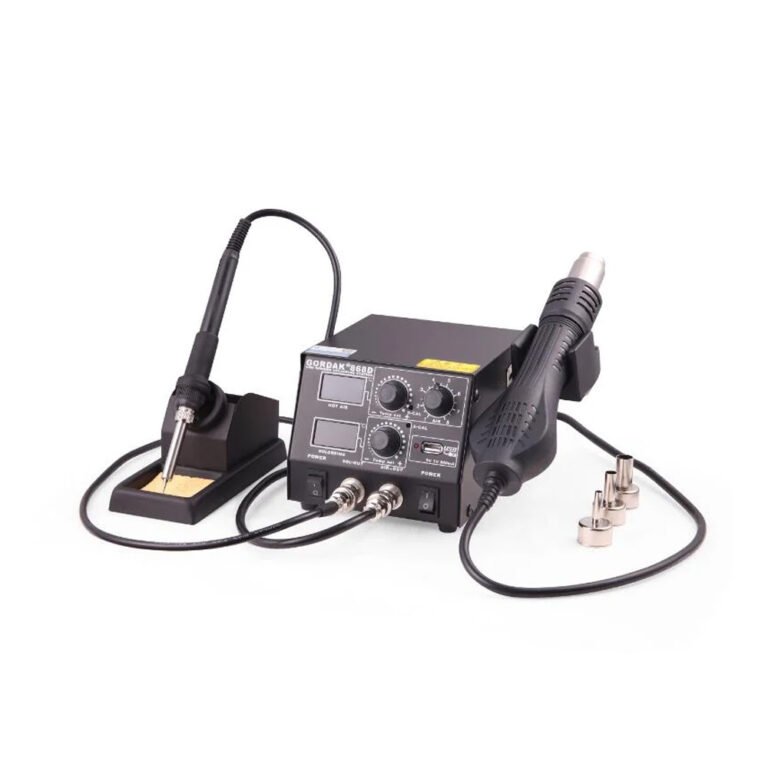热风焊接站是现代电子产品维修的必备工具,尤其是在处理表面贴装器件 (SMD) 时。无论是回流焊、拆卸元件还是进行精密维修,学会如何正确操作热风站都能显著提高效率,降低损坏精密零件的风险。
在本指南中,我们将向您介绍如何像专业人员一样使用热风焊接站的专业步骤和最佳做法。
什么是热风焊接站?
热风焊接站使用加热气流熔化焊料,使您能够在不直接接触的情况下拆卸或安装元件。这些焊台尤其适用于
- 返工或更换 SMD 芯片
- 拆焊多针元件
- 焊点回流
与烙铁不同,热风工具提供非接触式热源,是敏感电子设备的理想选择。
Gordak 热风焊接站的基本功能
Gordak 的热风站设计精密可靠。主要特点包括
- 可调节温度和气流
- 数字控制面板,确保准确性
- 多种喷嘴类型
- 内置过热和 ESD 保护安全系统
分步指南:如何使用热风焊接台
1.设置温度和气流
根据所加工的元件和 PCB 调整工作台的温度和气流。一般来说
- 温度:280-350°C
- 气流对于小型组件,气流为低至中等;对于大型组件,气流较高
小贴士 有关热极限,请务必参阅制造商的数据表。
2.选择正确的喷嘴
选择与部件尺寸密切匹配的喷嘴。这样可以确保热量集中在需要的地方,降低损坏邻近部件的风险。
3.预热区域
对于大型或多层电路板,应将 PCB 预热至约 100-150°C 以减少热冲击。有些专业人员会使用预热板来完成这一步骤。
4.加热焊点
将热风喷嘴置于部件上方 3-5 毫米处。以小幅度的圆周运动移动喷嘴,使热量均匀分布。通常需要 5-10 秒钟来软化焊料。
小贴士 不要在一个点上停留太久,过热会损坏电路板。
5.取出或放置组件
焊料熔化后,使用精密镊子轻轻夹起或定位元件。注意不要用力。
6.逐渐降温
让元件和电路板自然冷却,避免温度骤变,以免造成裂缝或分层。
获得更好结果的专业技巧
- 在制作昂贵的印刷电路板之前,先在废电路板上进行练习
- 使用优质助焊剂改善焊料流动
- 返工后在显微镜下检查接缝
- 保持喷嘴和过滤器清洁
- 定期校准管理平台
应避免的常见错误
- 使用过大的气流,可能会吹走小部件
- 温度设置过高
- 喷嘴太靠近印刷电路板
- 处理元件时忽视 ESD 保护
为什么选择 Gordak 热气站?
Gordak 提供的高性能焊接解决方案深受全球专业人士的信赖。我们的热风返修站设计精密、安全、长期可靠。
- 通过 CE 认证和质量检测的设备
- 具有竞争力的工厂定价
- 提供 OEM/ODM 支持
- 专业技术指导
如需咨询、合作或批量订购,请通过以下方式联系我们 info@gordakelec.com.
结论
掌握热风焊台需要练习,但只要有正确的设置、工具和技术,您就能像真正的专业人士一样工作。无论您是在组装原型、维修智能手机,还是在处理细间距集成电路,Gordak 的优质热风焊台都是任何电子工作站的宝贵财富。
立即浏览我们的全系列热风站和配件。
电子邮件: info@gordakelec.com



